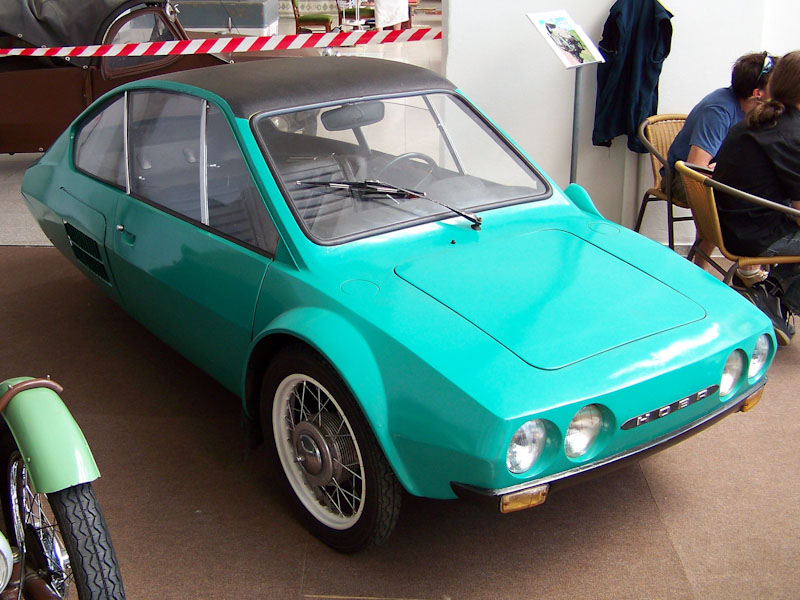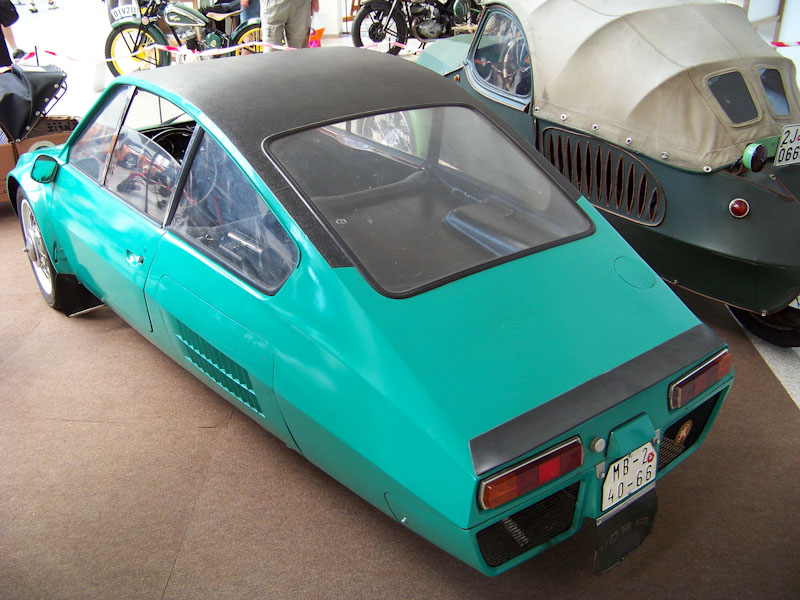You are using an out of date browser. It may not display this or other websites correctly.
You should upgrade or use an alternative browser.
You should upgrade or use an alternative browser.
WI: Microcars more common?
- Thread starter ArKhan
- Start date
I doubt you can get them to become much more popular. For one you can't put in eff all making them useless for anything beyond going somewhere where you don't have to bring stuff. Can't go grocery shopping with them. That means you'll still have to have another car or carry stuff around which sort of defeats the whole point. For two I wouldn't want to be in accident with anything heavy or strong. Gives you somewhat better protection than walking with all the dangers of driving.
Overall if you want stuff like this you'd better think about bubble of some sort for motorcycles that protect you from the weather.
Overall if you want stuff like this you'd better think about bubble of some sort for motorcycles that protect you from the weather.
Hell, the toy market would love them, people would (if they where cheap enough) buy them like they where OTL "Powerwheels" toys. Those technically count as electric microcars. If microcars where the same price as those toy cars all around the board (I'm talking 100s of dollars) would they be more common?According to wiki, you don't need a driving licence in some countries to drive one. If that were extended more generally (maybe requiring only a provisional licence like motorbikes), you could see young people driving them more.
According to wiki, you don't need a driving licence in some countries to drive one. If that were extended more generally (maybe requiring only a provisional licence like motorbikes), you could see young people driving them more.
I would also probably place limits on engine size (425-570cc max), power (40-58 bhp max) and weight (450-690 kg max) as well as limit a microcar's max speed (75 mph or roughly over 120 kph) and acceleration (0-60 cannot be slower than 12-13 seconds) so it can be safely and comfortably used on motorways.
And that is not forgetting that like the Mini (which destroyed the micro / bubble car), the continued success of the mircocar depends on the fact that it provides four adult seats and more practical long distance transport at a lower cost.
If a 3-wheeler of some form, than a tilting capability to improve stability is a must as is a "tadpole" layout with 2-wheels at the front and 1-wheel at the rear (while the "delta" layout with 2-wheels at the rear and 1-wheel at the front could still be used for micro-vans/pick-ups) though I'm not sure how it would be possible to make it a more practical 4-seater "tadpole" 3-wheeler microcar unless it was enlarged a bit (both in width and length) with the engine at the rear.
Last edited:
As others have mentioned, the safety issues in accidents with full size autos make a widespread use age of microcars difficult. If you can sharply decrease the amount of normal autos on the road it may be possible.
Building upon my previous comment from a while back, in order for more practical 2/3/4-seater "tadpole" 3-wheeler microcars (with luggage space in the front end) to be built and became common it would be a very good idea to have such microcars externally appear not that too far removed from a regular 4-wheeled car (along with possibly including Kei Car-like tax incentives), something akin to the stillborn Czech-built Velorex-based Hoba and Hoba II prototypes (http://www.avia350.cz/en_hoba.html) albeit possibly built by a major carmaker or various motorcycle manufacturers (even a few that would have otherwise become defunct in OTL).
Hoba


Hoba II


Hoba


Hoba II


Last edited:
If it were to happen in North America, the traffic fatality rate would rise, with most of the newer casualties coming from truck/microcar accidents in rush hour/bad weather. Indeed, a sizable casualty list could result from midday interstate driving: suppose traffic were moving along normally on an interstate (say, ~65 mph) with a tractor-trailer in the rightmost of three lanes and the other lanes well populated by microcars. The divider between the two directions of traffic is a jersey barrier: one of those uncompromising concrete walls. Now suppose the tractor-trailer has a sudden, precipitous blowout on the front axle. That could yield loss of control of the truck at speed, causing it to swerve uncontrollably into the other lanes, wiping out multiple microcars before finally coming to rest, likely on its side with a couple of microcars trapped underneath.
In the USA you'd need legislation to favor microcars in cities (tax incentives, parking rules etc). Outside of cities you'd need to keep them off major highways (interstates etc) for safety reasons. They would be OK on smaller 2 lane roads, and potentially useful for rural residents, but competing with regular autos & trucks on high speed limited access highways they are death traps.
IN the USA...
No interstate highways
Efficient intercity and commuter rail systems throughout the country
less suburban sprawl
Smaller families
Much earlier dependence on foreign oil
Reduced safety and elimination of crash test standards that favor big cars.
But to be honest, if you have efficient commuter transit options and less sprawl,why do you need microcars anyway? Basically, I do not believe microcars could ever catch on in the USA except as a niche "statement" vehicle or part of a public "drive and drop" urban car rental system.
No interstate highways
Efficient intercity and commuter rail systems throughout the country
less suburban sprawl
Smaller families
Much earlier dependence on foreign oil
Reduced safety and elimination of crash test standards that favor big cars.
But to be honest, if you have efficient commuter transit options and less sprawl,why do you need microcars anyway? Basically, I do not believe microcars could ever catch on in the USA except as a niche "statement" vehicle or part of a public "drive and drop" urban car rental system.
I agree that it would be unlikely car-like (as opposed to oddball) microcars would ever catch on in America, unless such cars were associated with a popular subculture like for example "Americanized" Mods who used microcars in place of scooters similar to how Hippies took to the VW Beatle or Citroen 2CV (which to be frank were not that much safer).
Though it would be another matter in places like Europe, South America, parts of Asia (outside of Japan) and even the Communist Bloc (that could have helped motorize the masses), especially if Kei Car-style tax benefits were given to all car-like microcars (3/4-wheelers) below a certain displacement / weight / top speed / etc, which would have perhaps prevented microcars from completely dying out when the original Mini was launched in 1959.
Though it would be another matter in places like Europe, South America, parts of Asia (outside of Japan) and even the Communist Bloc (that could have helped motorize the masses), especially if Kei Car-style tax benefits were given to all car-like microcars (3/4-wheelers) below a certain displacement / weight / top speed / etc, which would have perhaps prevented microcars from completely dying out when the original Mini was launched in 1959.
Microcars (and to some degree, economy cars) do have another advantage apart from fuel use and parking space, steering force. Having had a car with unassisted steering myself, I can tell you that even an economy car is something of a b**** to steer at crawl speeds (the sort you use when backing into/out of a driveway), and would be impossible for at least some old ladies, so that's one niche market.
Microcars (and to some degree, economy cars) do have another advantage apart from fuel use and parking space, steering force. Having had a car with unassisted steering myself, I can tell you that even an economy car is something of a b**** to steer at crawl speeds (the sort you use when backing into/out of a driveway), and would be impossible for at least some old ladies, so that's one niche market.
In more potent form it could also cater to the enthusiast looking for something simple and low-cost yet feels much faster then it goes especially if the microcars weight under 550-600kg, even in spite of potential regulations limiting a microcar's max speed / displacement it could still possess plenty of low speed acceleration (add to the fact that quite a few would likely apply their motorcycle expertise similar what Honda did with the Honda S500).
Last edited:
Ive seen SmartCars parked such that you could fit two in one parallel parking spot.
Big cities, like NYC, London, Tokyo, or Toronto that have severely restricted parking could be a driver for such cars.
If parking costs are half those of regular cars, or regular cars are banned from parts of the city, thatd be a big incentive.
Big cities, like NYC, London, Tokyo, or Toronto that have severely restricted parking could be a driver for such cars.
If parking costs are half those of regular cars, or regular cars are banned from parts of the city, thatd be a big incentive.
1. a regulatory condition that favours them e.g. like the Kei cars in japan - which would create a situation where a 'just a bit bigger' miniturised 'proper' car like the Original BMC mini is seen less favourably...
2. operational conditions that favour micro cars
e.g. for the US a situation where the age for driving 'normal' cars is set at 17 or 18 but microcars can be driven at 14 or 15
3. higher fuel prices and a more severe interuption in oil supply from the various oil crisis e.g. suez and 1973
2. operational conditions that favour micro cars
e.g. for the US a situation where the age for driving 'normal' cars is set at 17 or 18 but microcars can be driven at 14 or 15
3. higher fuel prices and a more severe interuption in oil supply from the various oil crisis e.g. suez and 1973
The last micro-car boom was driven by the devastation and poverty following WWII. I wouldn't recommend duplicating the effect. I've driven an Isetta and you wouldn't worry about driving it on the highway. You wouldn't. I also drove in a Honda 360 car, on a highway. It was an adventure, and the car didn't outlive it by much. I owned a Renault Dauphin, which weighed 880 lbs. The day it hit 65 mph, it burned a valve.
I talked to a courier who drove a smartcar. He said the dealer charged him $750 for the 48,000 km inspection. He questioned the price, and the dealer explained that he saved that much on fuel. Smart.
I can't wait to see 14 year old drivers culling the population.
I talked to a courier who drove a smartcar. He said the dealer charged him $750 for the 48,000 km inspection. He questioned the price, and the dealer explained that he saved that much on fuel. Smart.
I can't wait to see 14 year old drivers culling the population.
Share: